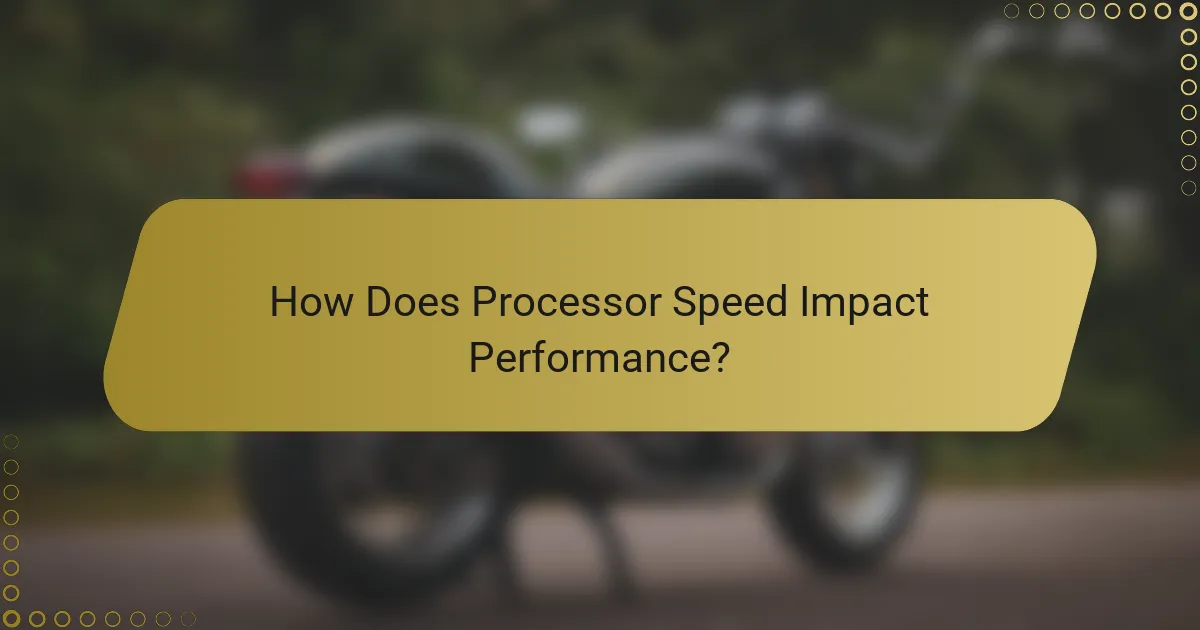Processors, or central processing units (CPUs), are essential components that execute instructions in computing devices, influencing overall system performance and efficiency. Key factors affecting processor performance include core count, which refers to the number of individual processing units within a CPU, and processor speed, measured in gigahertz (GHz), which determines how quickly instructions are executed. Higher core counts enable better multitasking and improved performance in demanding applications, while increased clock speeds enhance responsiveness and reduce lag. This guide provides an in-depth look at these critical aspects of processors, including their impact on computing efficiency and the importance of software optimization in leveraging multi-core capabilities.

What are Processors and Why are They Important?
Processors are the central processing units (CPUs) that execute instructions in computers and other devices. They perform calculations, manage data flow, and control other components. Processors are crucial because they determine a system’s performance and efficiency. A more powerful processor can handle more tasks simultaneously and process data faster. For example, modern processors can have multiple cores, allowing them to execute several instructions at once. This multi-core capability enhances multitasking and improves overall system responsiveness. According to Intel, a higher clock speed in a processor leads to quicker data processing. Thus, processors play a vital role in the functionality and speed of computing devices.
How do Processors Function in a Computer System?
Processors function as the central processing unit (CPU) in a computer system. They execute instructions from programs by performing calculations and processing data. The CPU interprets instructions through a fetch-decode-execute cycle. During the fetch phase, it retrieves instructions from memory. In the decode phase, it translates instructions into a format the CPU can understand. The execute phase involves carrying out the instructions, which may include arithmetic operations or data movement.
Modern processors have multiple cores, allowing them to perform several tasks simultaneously. This parallel processing capability enhances performance, especially for multitasking and complex applications. Cache memory, located within the CPU, stores frequently accessed data to speed up processing. The efficiency of a processor is influenced by its clock speed, measured in gigahertz (GHz), which indicates how many cycles it can perform per second. Overall, processors are essential for executing software and managing hardware interactions in a computer system.
What are the Basic Components of a Processor?
The basic components of a processor include the Arithmetic Logic Unit (ALU), Control Unit (CU), and registers. The Arithmetic Logic Unit performs mathematical calculations and logical operations. The Control Unit directs the operation of the processor and coordinates the activities of its components. Registers are small storage locations within the CPU that hold data temporarily for quick access. Together, these components enable the processor to execute instructions and manage data flow efficiently.
How do Processors Execute Instructions?
Processors execute instructions through a series of steps known as the instruction cycle. This cycle includes fetching, decoding, executing, and storing results. First, the processor fetches the instruction from memory. It uses the program counter to locate the next instruction.
Next, the processor decodes the fetched instruction to determine the required operation. This involves interpreting the opcode and identifying operands. Following this, the processor executes the instruction. Execution may involve arithmetic operations, data movement, or control flow changes.
Finally, the processor stores the result back in memory or a register. This cycle repeats for each instruction in a program. The efficiency of this process is influenced by factors such as clock speed and core count.
What Factors Determine Processor Performance?
Processor performance is determined by several key factors. These include core count, clock speed, and cache size. Core count refers to the number of processing units within the CPU. More cores enable better multitasking and parallel processing. Clock speed, measured in gigahertz (GHz), indicates how many cycles a processor can execute per second. Higher clock speeds generally lead to better performance in single-threaded tasks. Cache size affects how quickly a processor can access frequently used data. Larger caches reduce latency and improve overall speed. Additionally, architecture and thermal design power (TDP) influence performance and efficiency. These factors collectively determine how well a processor performs in various computing tasks.
How Does Core Count Affect Processing Power?
Core count directly affects processing power by determining how many tasks a CPU can handle simultaneously. More cores enable better multitasking and improved performance in multi-threaded applications. For instance, a quad-core processor can execute four threads at once, while an octa-core can handle eight. This allows for faster processing in applications like video editing and gaming. Additionally, higher core counts can lead to increased efficiency in server environments where multiple processes run concurrently. According to benchmarks, CPUs with higher core counts often outperform those with fewer cores in demanding tasks. Thus, core count is a crucial factor in assessing a processor’s overall performance.
What Role Does Processor Speed Play in Performance?
Processor speed plays a crucial role in overall performance. It determines how quickly a processor can execute instructions. Higher processor speeds result in faster data processing and improved application responsiveness. For instance, processors with speeds measured in gigahertz (GHz) can perform billions of cycles per second. This speed affects tasks ranging from simple calculations to complex simulations. Benchmarks show that a 3.0 GHz processor can outperform a 2.0 GHz processor by a significant margin in intensive applications. Therefore, processor speed is a fundamental aspect influencing computing performance.
How is Cache Size Related to Processing Efficiency?
Cache size directly impacts processing efficiency by determining how much data can be stored for quick access. A larger cache size allows more data to be held close to the CPU, reducing the time needed to retrieve information. When the CPU accesses data from the cache, it operates significantly faster than fetching it from main memory. Studies show that processors with larger caches can improve performance by up to 30% in data-intensive applications. This is because fewer operations are needed to access frequently used data. Consequently, the efficiency of processing tasks is enhanced, leading to faster execution times.

What is Core Count and Why Does it Matter?
Core count refers to the number of individual processing units within a CPU. Each core can execute its own thread of instructions, allowing for parallel processing. A higher core count generally enhances a CPU’s ability to multitask and handle demanding applications. For example, modern CPUs may have anywhere from 2 to 64 cores. This increase in cores can significantly improve performance in tasks like video editing, gaming, and running virtual machines. Additionally, software optimization plays a crucial role; not all applications utilize multiple cores effectively. Therefore, understanding core count helps users choose the right CPU for their needs.
How Does Core Count Influence Multitasking Capabilities?
Core count directly influences multitasking capabilities. More cores allow a processor to handle multiple tasks simultaneously. Each core can execute separate threads, improving overall efficiency. For example, a quad-core processor can manage four tasks at once. This reduces lag and enhances performance during heavy workloads. Studies show that applications optimized for multi-core processors benefit significantly from higher core counts. In benchmarks, processors with more cores demonstrate superior multitasking performance compared to those with fewer cores. Therefore, increased core count is crucial for effective multitasking.
What is the Difference Between Single-Core and Multi-Core Processors?
Single-core processors have one processing unit, while multi-core processors have multiple units. This fundamental difference affects performance and multitasking capabilities. Single-core processors execute one task at a time. Multi-core processors can handle several tasks simultaneously. This leads to improved efficiency in multi-threaded applications. For example, modern multi-core processors can run complex software more smoothly. Performance benchmarks show that multi-core processors outperform single-core ones in most scenarios. Therefore, multi-core processors are generally preferred for demanding applications.
How Many Cores Do Most Users Need?
Most users need between 4 to 8 cores for optimal performance. This range supports everyday tasks like web browsing, office applications, and media consumption. For gaming, 6 cores are often recommended to ensure smooth gameplay. Many modern games utilize multiple cores efficiently. Higher core counts, such as 8 to 16, benefit power users and professionals in video editing or 3D rendering. These tasks can leverage more cores for faster processing. According to a report by PassMark Software, CPUs with 4 to 8 cores dominate the consumer market. This indicates that the majority of users find this core count sufficient for their needs.
What are the Different Types of Processor Cores?
The different types of processor cores include single-core, dual-core, quad-core, hexa-core, octa-core, and multi-core processors. Single-core processors have one core, limiting multitasking capabilities. Dual-core processors contain two cores, improving performance for basic tasks. Quad-core processors feature four cores, enhancing multitasking and processing power. Hexa-core processors include six cores, suitable for more demanding applications. Octa-core processors have eight cores, offering superior performance for gaming and multimedia tasks. Multi-core processors can have more than eight cores, designed for high-performance computing. Each type of core configuration provides varying levels of performance and efficiency, tailored to specific user needs and applications.
What is the Role of Physical vs. Logical Cores?
Physical cores are the actual hardware units within a CPU that perform computations. Each physical core can handle one or more threads simultaneously. Logical cores, on the other hand, are virtual cores created through technologies like Intel’s Hyper-Threading. This allows a single physical core to run two threads, effectively doubling the number of logical cores.
The role of physical cores is to provide the main processing power of the CPU. They execute instructions and perform calculations directly. Logical cores enhance the efficiency of physical cores by allowing better utilization of resources. This leads to improved multitasking and performance in applications designed for parallel processing.
Proof of this can be seen in benchmarks where CPUs with more logical cores outperform those with fewer physical cores in multi-threaded tasks. For instance, a quad-core processor with Hyper-Threading can handle eight threads, resulting in significant performance gains in applications that support multi-threading.
How Do Specialized Cores Enhance Performance?
Specialized cores enhance performance by optimizing processing tasks for specific workloads. These cores are designed to handle particular functions more efficiently than general-purpose cores. For example, a graphics processing unit (GPU) has specialized cores for rendering images. This allows for faster processing times in graphics-intensive applications. Additionally, machine learning tasks benefit from specialized cores that accelerate neural network computations. Research shows that systems with specialized cores can achieve significant performance improvements, sometimes exceeding traditional CPU performance by several folds in specific tasks. This targeted design leads to better energy efficiency and reduced latency, further enhancing overall system performance.

How Does Processor Speed Impact Performance?
Processor speed significantly impacts performance by determining how quickly a CPU can execute instructions. Higher processor speeds, measured in gigahertz (GHz), allow for more cycles per second. This leads to faster processing of tasks and improved responsiveness in applications. For example, a 3.0 GHz processor can perform tasks more quickly than a 2.0 GHz processor under similar conditions. Increased speed enhances multitasking capabilities and reduces lag in demanding applications. Studies show that higher clock speeds correlate with better performance metrics in benchmarks. Therefore, processor speed is a critical factor in overall computing efficiency.
What is Meant by Clock Speed in Processors?
Clock speed in processors refers to the frequency at which a CPU executes instructions. It is measured in hertz (Hz), typically gigahertz (GHz) for modern processors. A higher clock speed indicates a faster processor, capable of executing more instructions per second. For example, a 3.0 GHz processor can perform three billion cycles per second. This speed affects overall performance, particularly in tasks requiring high processing power. However, clock speed is not the sole determinant of performance. Factors like core count and architecture also play significant roles.
How Does Clock Speed Affect Overall Performance?
Clock speed directly affects overall performance by determining how many cycles a CPU can execute per second. Higher clock speeds generally lead to faster processing times. For example, a CPU running at 3.0 GHz can perform three billion cycles per second. This increased speed allows for quicker data processing and task execution. However, clock speed is not the only factor influencing performance. Other elements like core count and architecture also play significant roles. In some cases, a CPU with a lower clock speed but more cores can outperform a higher clock speed CPU in multi-threaded tasks. Thus, while clock speed is crucial, it should be considered alongside other specifications for a complete performance assessment.
What are Turbo Boost and Overclocking?
Turbo Boost and Overclocking are techniques used to enhance processor performance. Turbo Boost is an Intel technology that automatically increases the processor’s clock speed beyond its base frequency when needed. This allows for improved performance during demanding tasks without user intervention. Overclocking involves manually adjusting the processor’s settings to run at higher speeds than the manufacturer’s specifications. This can lead to increased performance but may also cause overheating or instability. Both methods aim to optimize computing power for better performance in various applications.
Why is Cache Size Significant in Processors?
Cache size is significant in processors because it directly affects the speed and efficiency of data retrieval. Larger cache sizes allow for more data to be stored closer to the processor. This reduces the time needed to access frequently used data. When the processor can retrieve data from the cache instead of slower main memory, overall performance improves. Research shows that processors with larger caches can achieve up to 30% better performance in data-intensive applications. Effective cache size management can also minimize latency, enhancing the processor’s ability to execute tasks quickly. Thus, cache size plays a crucial role in determining a processor’s performance capabilities.
What are the Different Levels of Cache?
The different levels of cache in processors are L1, L2, and L3. L1 cache is the smallest and fastest, located closest to the CPU cores. It typically ranges from 16KB to 64KB per core. L2 cache is larger than L1, usually between 256KB to 1MB per core, and is slower than L1. L3 cache is shared among cores, ranging from 2MB to 64MB, and is slower than both L1 and L2. These cache levels improve data access speed, reducing latency and enhancing overall processor performance.
How Does Cache Size Affect Data Access Speed?
Cache size directly influences data access speed. Larger cache sizes allow more data to be stored closer to the processor. This proximity reduces the time needed to retrieve data. When the processor accesses data from cache, it is significantly faster than retrieving it from main memory. For example, accessing data from L1 cache can be 1 to 5 cycles, while accessing from RAM can take 100 cycles or more. Therefore, a larger cache can lead to fewer cache misses. This results in improved performance and efficiency in processing tasks. Studies show that increasing cache size can lead to better overall system performance.
What Best Practices Should Users Follow When Choosing a Processor?
Users should consider several best practices when choosing a processor. First, evaluate the core count. More cores can improve multitasking and performance in demanding applications. Second, assess the clock speed. Higher speeds generally result in better performance for single-threaded tasks. Third, check the thermal design power (TDP). A lower TDP indicates better energy efficiency. Fourth, look at the processor’s generation. Newer generations typically offer enhanced performance and features. Fifth, consider the compatibility with existing hardware. Ensure the processor fits the motherboard socket type. Finally, read reviews and benchmarks. These provide insights into real-world performance and reliability.
Processors, or central processing units (CPUs), are critical components in computing devices responsible for executing instructions, performing calculations, and managing data flow. This comprehensive guide explores essential aspects of processors, including core count, speed, and cache size, detailing how these factors influence performance and efficiency. Key topics include the function of processors, the significance of core count for multitasking, the impact of clock speed on processing capabilities, and the role of cache size in data access speed. Understanding these elements is crucial for selecting the right processor to meet specific computing needs.
